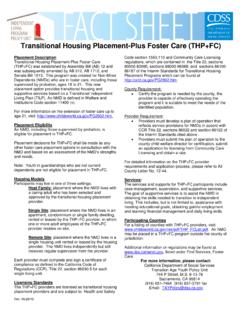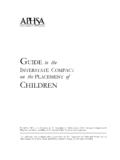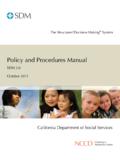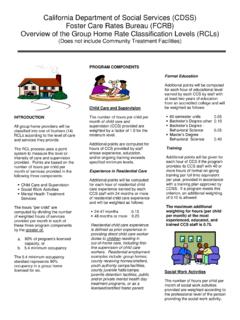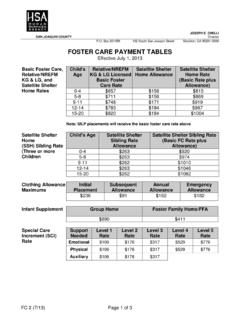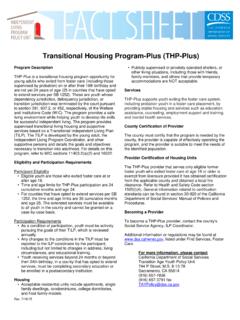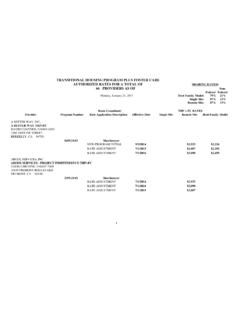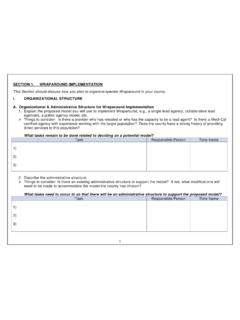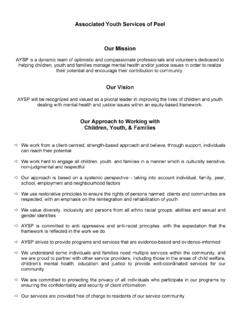Transcription of After 18 Program - childsworld.ca.gov
1 Rev. 11/14/16 After 18 Program Summary The California Fostering Connections to Success Act was signed into law September 30, 2010 through Assembly Bill (AB) 12 and became effective January 1, 2012. The bill and subsequent legislation allowed foster care for eligible youth to extend beyond age 18 up to age 21. Eligible foster youth are designated as non-minor dependents (NMDs). This legislation also recognized the importance of family and permanency for youth by extending payment benefits and transitional support services for the Adoption Assistance Program (AAP) and the Kinship Guardianship Assistance Payment (Kin-GAP) Program .
2 Goals and Benefits Foster youth will be able to maintain a safety net of support while experiencing independence in a supervised living environment. Provides youth extended time as non-minor dependents to obtain educational and employment training opportunities which assist youth in becoming better prepared for successful transition into adulthood and self-sufficiency. Basic Eligibility Requirements At the six month hearing prior to youth turning age 18, the social worker/probation officer must have a plan to ensure the youth meet at least ONE of the following participation criteria: 1) Working toward completion of high school or equivalent Program ( GED); OR 2) Enrolled in college, community college or a vocational education Program ; OR 3) Employed at least 80 hours a month; OR 4) Participating in a Program designed to assist in gaining employment.
3 OR 5) Unable to do one of the above requirements because of a medical condition. Non-minor dependents must sign an agreement to reside in an eligible placement location and agree to work with a social worker/probation officer to meet the goals outlined in their Transitional Independent Living Case Plan. Remaining in foster care After age 18 is voluntary. Non-minor dependents can exit at age 18 or at any subsequent time before age 21. Youth who exit at age 18 can re-enter foster care at any time before age 21. Tribal youth under county jurisdiction are also eligible to remain in foster care After age 18.
4 Tribes with a Title IV-E agreement with the state or federal government can create their own extended foster care (EFC) Program . Probation youth who are in a foster care placement are also eligible for EFC. Foster Placement Options Eligible placement options for youth After age 18 include: 1) Remain in existing home of a relative or NREFM; licensed foster family home; certified foster family agency home; home of a non-related legal guardian whose guardianship was established by the juvenile court); or group home (youth may remain in a group home After age 19 only if the criteria for a medical condition is met and the placement is a short-term transition to an appropriate system of care).
5 Or 2) THP-Plus Foster Care (THP+FC) - this Program has three models: Host Family where the NMD lives with a caring adult who has been selected and approved by the transitional housing provider; Single Site where the NMD lives in an apartment, condominium or single family dwelling rented or leased by the housing provider with an employee(s) living on site; or Rev. 11/14/16 Remote Site where the NMD lives independently in one of the housing types listed above with regular supervision from the provider; or 3) Supervised Independent Living Placement (SILP) - this placement option allows youth to live independently in an apartment, house, condominium, room and board arrangement or college dorm, alone or with a roommate(s), while still receiving the supervision of a social worker/probation officer.
6 The youth may directly receive all or part of the foster care rate pursuant to the mutual agreement. AAP and Kin-GAP extended benefits After age 18 For AAP, the initial AAP agreement must have been signed when the child/youth was at least 16-years old. For Kin-GAP, the child/youth must have attained 16-years of age before the Kin-GAP negotiated agreement payments commenced. Both AAP and KinGap youth must meet at least one of the participation criteria listed above. Additional information Youth who are custodial parents have the same rights to participate in foster care After age 18 as all other youth.
7 Youth who are consumers of Regional Center services can continue to receive dual agency and supplemental rates. Youth who meet the eligibly requirements to receive SSI (Supplemental Security Income) MAY be eligible to receive both at the same time. For more information visit: If you have questions or need additional information please email them to.
